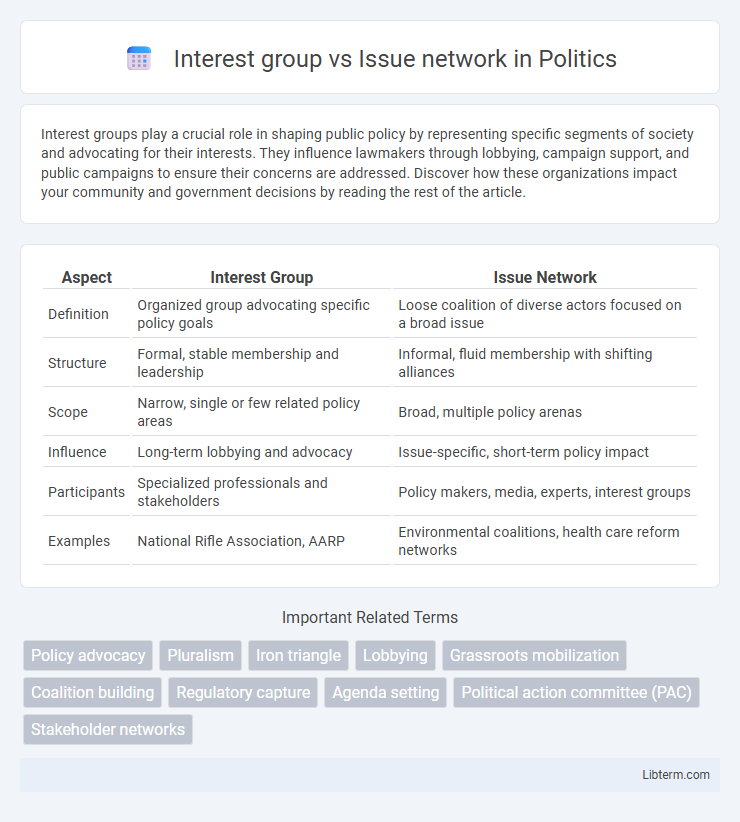Interest groups play a crucial role in shaping public policy by representing specific segments of society and advocating for their interests. They influence lawmakers through lobbying, campaign support, and public campaigns to ensure their concerns are addressed. Discover how these organizations impact your community and government decisions by reading the rest of the article.
Table of Comparison
| Aspect | Interest Group | Issue Network |
|---|---|---|
| Definition | Organized group advocating specific policy goals | Loose coalition of diverse actors focused on a broad issue |
| Structure | Formal, stable membership and leadership | Informal, fluid membership with shifting alliances |
| Scope | Narrow, single or few related policy areas | Broad, multiple policy arenas |
| Influence | Long-term lobbying and advocacy | Issue-specific, short-term policy impact |
| Participants | Specialized professionals and stakeholders | Policy makers, media, experts, interest groups |
| Examples | National Rifle Association, AARP | Environmental coalitions, health care reform networks |
Introduction to Interest Groups and Issue Networks
Interest groups are organized entities that actively seek to influence public policy by representing specific interests, often with formal structures and long-term goals. Issue networks consist of fluid, informal alliances among various stakeholders such as interest groups, policymakers, and experts collaborating on specific policy issues. These networks emphasize flexibility and diverse participation compared to the more stable and focused nature of interest groups.
Defining Interest Groups: Core Characteristics
Interest groups are organized entities that seek to influence public policy by representing specific interests, characterized by a formal structure, membership cohesion, and sustained advocacy efforts. They maintain clear goals, stable funding sources, and strategic lobbying activities aimed at policymakers. Unlike issue networks, which are fluid coalitions of varied actors focusing on specific policy problems, interest groups have a consistent, long-term presence in the political landscape.
Understanding Issue Networks: Key Features
Issue networks consist of diverse groups including policymakers, experts, and interest groups that collaborate on specific policy issues, characterized by fluid membership and expert knowledge exchange. Unlike traditional interest groups that have a stable organizational structure and focused advocacy goals, issue networks emphasize dynamic interactions and broad participation across multiple stakeholders. This flexibility allows issue networks to adapt quickly to changing political environments and complex policy challenges, enhancing their influence on legislative processes.
Historical Evolution of Advocacy Models
Interest groups have historically emerged as structured organizations with clearly defined memberships and formal leadership, focusing on influencing public policy through lobbying and political contributions, while issue networks evolved later as more fluid, decentralized coalitions involving diverse stakeholders such as advocacy organizations, media, and government officials. The transition from traditional interest groups to issue networks reflects a response to increasing policy complexity and pluralism in democratic governance during the late 20th century. This evolution highlights a shift from rigid, closed advocacy models to dynamic, open systems capable of addressing multifaceted public issues with broader participation.
Structure and Organization: Comparing Interest Groups and Issue Networks
Interest groups exhibit a formal and hierarchical structure with defined leadership, membership, and clear policy goals, fostering cohesive and sustained advocacy efforts. Issue networks consist of loosely connected, diverse actors such as policymakers, experts, and activists collaborating temporarily around specific policy issues, resulting in flexible and dynamic organization. This contrast highlights that interest groups maintain stable organizational frameworks, while issue networks adapt fluidly to shifting political environments.
Methods of Influence and Policy Advocacy
Interest groups use formal lobbying, campaign contributions, and organized grassroots mobilization to influence legislators and policymakers directly, often maintaining stable, long-term relationships with government officials. Issue networks consist of diverse stakeholders including experts, media, and public officials who collaborate more fluidly through information sharing, public campaigns, and informal alliances to shape policy debates on specific matters. Both employ targeted communication strategies and public engagement, but interest groups emphasize sustained advocacy while issue networks leverage dynamic, cross-sector interaction for policy impact.
Examples of Prominent Interest Groups and Issue Networks
Prominent interest groups such as the American Medical Association (AMA) and the National Rifle Association (NRA) wield significant influence through organized lobbying and member-based advocacy. Issue networks, exemplified by the coalition surrounding climate change policy, include a diverse array of participants like environmental NGOs, scientific experts, government agencies, and industry representatives working collaboratively on specific policy issues. The distinction lies in the structured membership of interest groups versus the fluid, dynamic alliances characteristic of issue networks.
Roles in Policymaking: Contrasts and Overlaps
Interest groups play a critical role in policymaking by directly lobbying government officials, mobilizing voters, and providing expert information to influence legislative outcomes, often representing focused, well-organized constituencies. Issue networks consist of diverse actors, including interest groups, policymakers, academics, and media, collaborating on complex policy issues through fluid alliances and information sharing, allowing for broader participation and dynamic policy development. Both structures shape policy by facilitating communication and advocacy, but interest groups tend to have more stable, targeted agendas while issue networks exhibit flexibility in addressing multifaceted problems.
Impact on Democratic Processes
Interest groups consolidate specific member interests, lobbying policymakers to influence legislation and public policy, which can enhance democratic representation but also risk privileging well-funded entities. Issue networks consist of diverse stakeholders including government officials, experts, and activists collaborating on policy matters, fostering more dynamic and inclusive debate that can improve transparency and responsiveness in democratic processes. Both structures shape agenda-setting and policy outcomes, impacting citizen participation and accountability within democratic governance.
Future Trends in Political Advocacy
Interest groups are increasingly adapting to digital platforms, leveraging data analytics and AI to enhance targeted advocacy, while issue networks remain flexible, allowing diverse stakeholders to collaborate on multifaceted policy challenges. The rise of decentralized social media and virtual lobbying is reshaping how both interest groups and issue networks mobilize support and influence policymakers. Future political advocacy will likely emphasize hybrid models combining traditional interest group resources with the dynamic, issue-specific coalitions characteristic of issue networks.
Interest group Infographic

 libterm.com
libterm.com